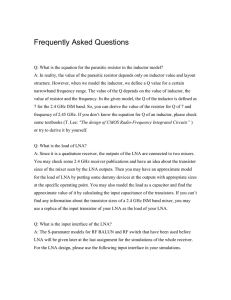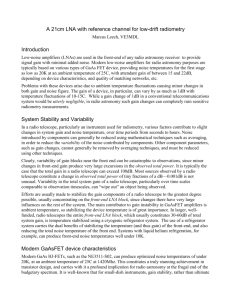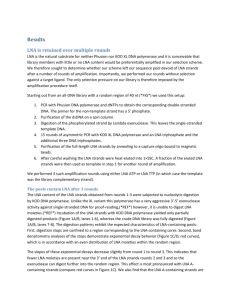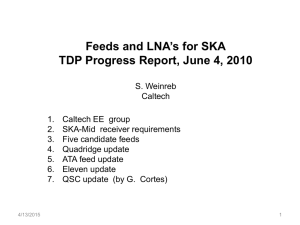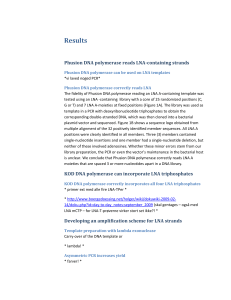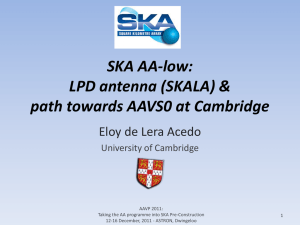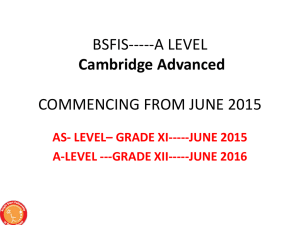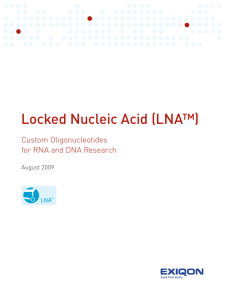AA-lo LNA AA
advertisement
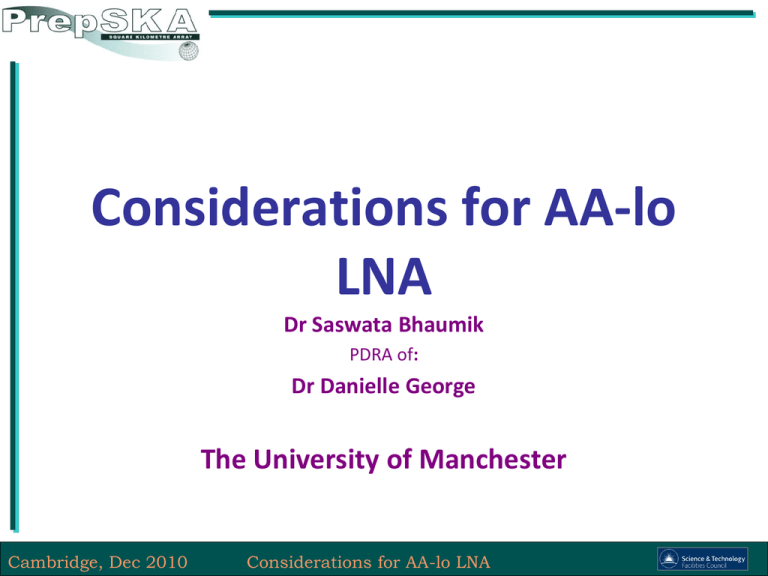
Considerations for AA-lo LNA Dr Saswata Bhaumik PDRA of: Dr Danielle George The University of Manchester Cambridge, Dec 2010 Considerations for AA-lo LNA Overview • Hybrid LNA simulations Performances of LNA1 and LNA2 • MMIC process considerations Reproducibility, Repeatability, Yield, Availability, Power, Temperature Stability • Interface with Antenna Investigation of interface between LNA and Antenna is very important Cambridge, Dec 2010 Considerations for AA-lo LNA AA-lo hybrid LNA simulations LNA1 Cambridge, Dec 2010 Considerations for AA-lo LNA LNA2 AA-lo LNA AA-lo LNA: AA-lo MMIC LNA: Low loss Baluns. Matured process Single ended LNAs. Excellent repeatability and yield Overall noise figure should be less than sky noise. High transconductance and low noise Simulated results: 5. LNA1: 1. Two hybrid LNA designs. 2. 2-stage LNAs with differential input and single ended output. 3. Enhancement mode pHEMTs of Avago Technology 4. Operational from 50MHz to 400MHz. • • Cambridge, Dec 2010 Low cost • • Gain above 25dB. NT below 35Kelvin between 100MHz and 450MHz 20Kelvin at 330MHz. 4V – 121mA drain bias (at PSU). P1dBIN point of -23dBm at 0.4GHz. Considerations for AA-lo LNA 6. LNA2: • • • • Gain above 36.7dB. NT below 36Kelvin. P1dBIN is -24dBm at 0.4GHz. 3V – 60mA drain bias and 0.5V at gate List of Measured HEMT Samples Process Sizes Different samples S-parameter Samples Noise Samples 1 2 3 4 5 6 7 8 9 8 9 4 7 8 6 1 1 3 8x4 9x4 4x4 7x4 8x3 6x3 1x6 1x6 3x6 7x2 5x2 4x2 4x2 8x2 3x2 - 150nm GaAs pHEMT 150nm GaAs mHEMT 130nm GaAs pHEMT 100nm InP pHEMT 150nm GaAs mHEMT 70nm GaAs mHEMT 150nm GaAs pHEMT 100nm InP pHEMT 100nm GaAs pHEMT Total 52 190 54 9 types MMIC Parameters: 1. Reproducibility 2. Reliability 3. Yield 4. Future Availability 5. Power, Temperature, Cost Cambridge, Dec 2010 Details Ongoing/Future characterisation work: 1. HEMTs of 2/3 more processes 2. Further Characterisation of 2 of 9 above processes 3. Cryogenic characterisation of HEMTs of shortlisted processes Considerations for AA-lo LNA Process considerations Important parameters: 1. 2. 3. 4. Noise Measure Position Gamma Opt in Smith Chart Temperature dependency Power efficiency Cambridge, Dec 2010 pHEMT_sim_OMMIC..Sopt pHEMT_sim_OMMIC..Sopt[FreqCGN] Sopt Sopt[FreqCGN] Process Investigation based on power efficiency Loci of Γopt (0.000 to 0.000) freq (50.00MHz to 10.00GHz) Considerations for AA-lo LNA Temperature Dependency Process Investigation based on temperature dependency 1. Temperature fluctuation 0.120 0.300 -50degree C -50 degree C -30degree C varies gain and NT vital for long observations 3. 30 degree C 60degree C 0.200 0.150 0.100 Optimum biases change 0.080 60 degree C Transconductance (S) Temperature stabilisation is 0.100 0 degree C 30degree C Transconductance (S) 2. -30 degree C 0.250 0degree C 0.060 0.040 0.020 0.050 0.000 with temperature -0.50 4. Temperature stabilisation? Cambridge, Dec 2010 -1.00 0.000 -0.40 -0.30 -0.20 -0.10 0.00 0.10 0.20 -0.80 -0.60 -0.40 Considerations for AA-lo LNA 0.00 -0.020 0.30 Gate voltage (V) -0.20 Gate voltage (V) 0.20 Interface with Antenna Interface between antenna and LNA/balun is crucial for noise and gain ripple. Consideration must be given to practical implementation. Options – 1.Direct connection between Antenna and LNA –Differential Antenna and Differential/pseudo Differential LNA –Single-ended Antenna and Single-ended LNA 2.Balun in the Interface –Differential Antenna and Single-ended LNA (feasible for AA-lo SKA) Cambridge, Dec 2010 Considerations for AA-lo LNA Conclusions and Further Work AA-lo has different LNA design requirements to AA-mid. HEMTs of 9 processes investigated – 2 processes will be further investigated. 2/3 more processes will be investigated. Different pHEMT topologies superior to mHEMT topologies for AA SKA (considering factors discussed in previous slides). Different processes suitable for different frequency bands (AA-lo and AA-mid). MMIC version of AA-lo LNA has been designed for fabrication. Cambridge, Dec 2010 Considerations for AA-lo LNA
